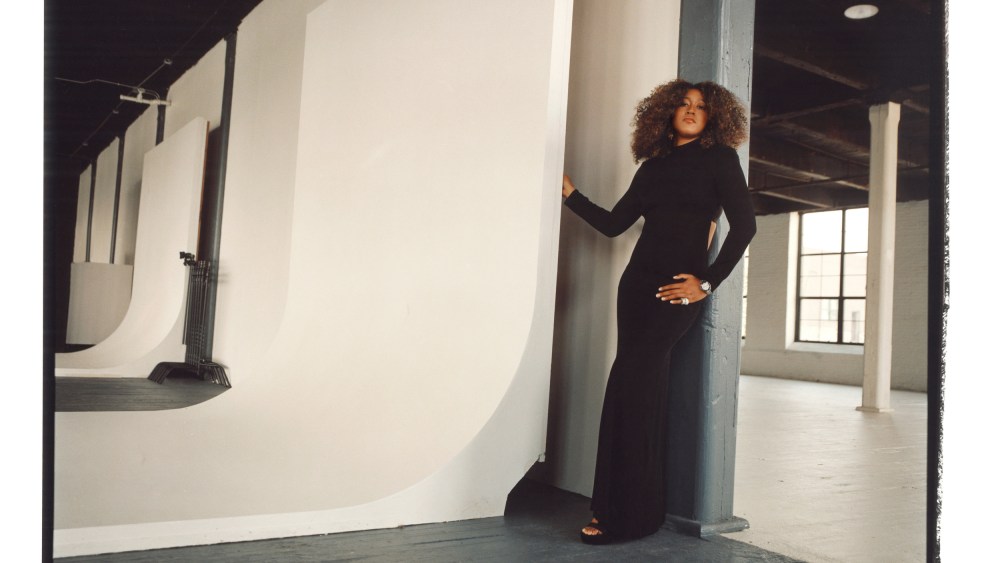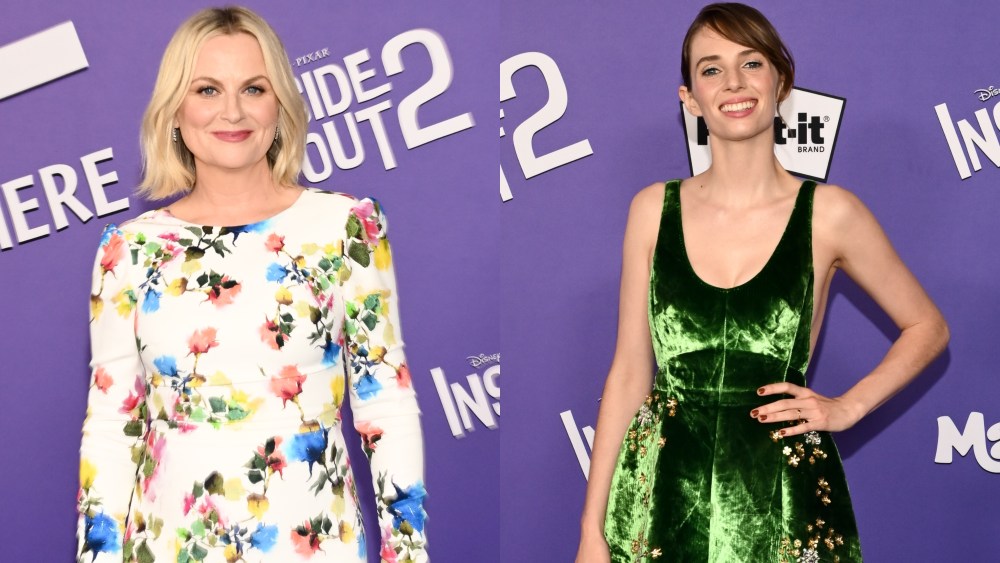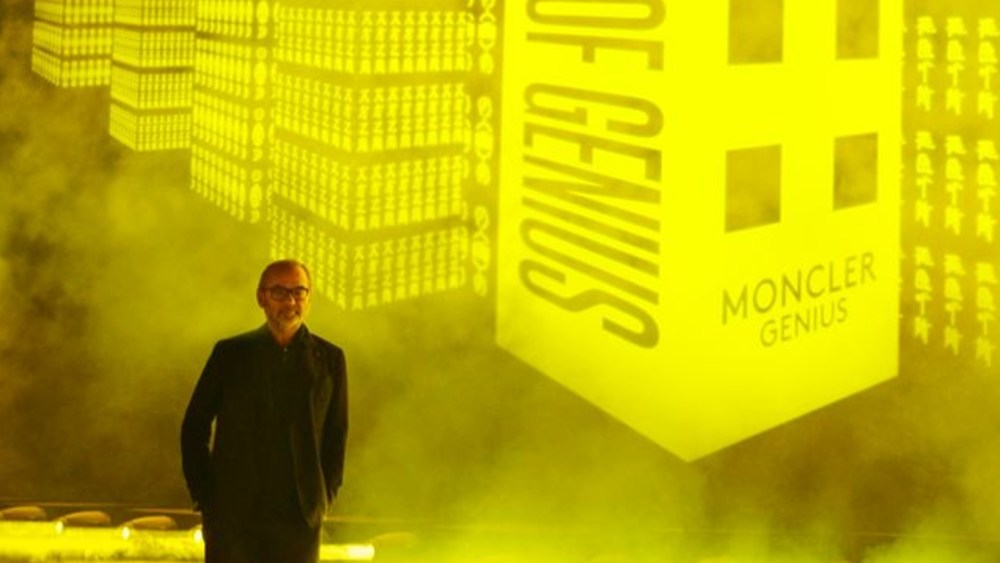Naomi Osaka stands on top of a New York City taxi parked askew in the middle of East 41st Street in Manhattan. It is a sweltering July day and Osaka is shooting a commercial for drugstore makeup brand Maybelline, her bright red lipstick stays put in the 88-degree heat (real feel 93). Her mane of spiral curls is styled in an up-down ‘do. She’s dressed head-to-toe in Nike (her apparel sponsor since 2019 with a deal that pays her more than $10 million annually) and holding a Yonex racket (another sponsor). She executes a series of quick, abbreviated forehands as the photographer shouts encouragement: “Beautiful!” “Nice!”
And since this is the tourist mecca of Bryant Park, a crowd begins to coalesce, a smattering at first, then swelling to a swarm with hundreds of smartphone-wielding onlookers clogging the sidewalk and spilling onto Fifth Avenue. Osaka continues to swing her racket. Turning her left hip slightly toward the camera, she looks out over the sea of people toward the New York Public Library. From her vantage point atop the yellow cab, she has an unobstructed view of Patience and Fortitude, the iconic marble lions that sit watch outside the library. Osaka spent part of her childhood in New York and she still finds the city liberating, even when the humanity bath is pressing in on her.
You May Also Like

A New Chapter
“I’ve never thought of myself as famous,” she says the next day. “When I think of famous people, I think of Beyoncé or Michael Jackson. They can’t go outside. And for me, I love being outside, especially in New York. I feel like I can walk forever.”
She pauses and laughs a little.
“And I feel like everyone in New York doesn’t care. Like, we’re all just living our lives. And for me, that’s one of the biggest reasons I love New York. You feel like you’re part of something and everyone is just trying their best in their own lives.”
At 26, with a baby daughter and after a 15-month break from tennis, Osaka is in a new chapter of her life. She became an overnight phenom when she beat Serena Williams in an indelible 2018 U.S. Open to become the first Japanese player to win a Grand Slam singles title. (Osaka was raised predominantly in the U.S., but represents Japan in tennis, where she was born to a Japanese mother and Haitian American father.) A string of championships followed (at the Australian Open in 2019 and 2021, and the 2020 U.S. Open) making her, at that time, the highest-earning female athlete with prize money and endorsements of more than $60 million.
By the time she lit the Olympic cauldron at the COVID-19-delayed Tokyo Summer Games in 2021, Osaka had achieved global stardom with more than a dozen sponsorship pacts across the U.S. and Asia (MasterCard, FTX, Beats, satellite broadcaster Wowow Inc., automaker Nissan and Japanese food giant Nissin). Unafraid to use her voice, and vulnerability, to focus the world’s attention on racial injustice, she has parlayed her social clout and prowess on the court into an entrepreneurial mini-empire that includes fashion collaborations with Louis Vuitton, Levi Strauss & Co., Tag Heuer and multiple collections with Nike, a sports management company (tennis star Nick Kyrgios is a client), a production company (investors include LeBron James’ and Maverick Carter’s SpringHill Company) and a girl-focused sports nonprofit.
But her ambitions beyond tennis are still very much intertwined with the sport that has consumed virtually her entire life. And since she returned to the tour in January (after giving birth to her daughter Shai, who turned one in July), Osaka has yet to make it past the second round of a Grand Slam tournament. (She was knocked out in the third round at Indian Wells and was eliminated in the first round at the Paris Summer Olympics.)
But interpreting Osaka’s comeback is, like Osaka herself, a little complicated. At the French Open, she was at match point in the second round with number-one seed Iga Swiatek, who would go on to win her third consecutive women’s singles titles at Roland Garros. Less than two months later, Osaka lost badly to Emma Navarro (6-4, 6-1) in the second round at Wimbledon. After the loss to Swiatek, notes veteran tennis writer Ben Rothenberg, “She said, in very Naomi style, that she felt like she was playing well, but, quote, ‘The results have not been resulting.’ Meaning she’s doing everything but winning.”
Of course, success in tennis, as in most sports, is binary. Asked about her performance since she returned to tennis, Osaka’s response conjures her recent effort at emotional equilibrium. “I’ve never been good [at losing],” she admits. “But I realize now, like as long as I learned from it, it’s not something I should be ashamed about. Especially since coming back, I’m trying to be a lot nicer to myself.”
A Father’s Dreams
Osaka has been swinging a tennis racket since she was three years old. That’s when the family moved from Osaka, Japan, to Long Island, N.Y., to live with her paternal grandparents so that her father, Leonard Francois, could begin the project of turning Naomi and her older sister Mari into the next Venus and Serena. (Her mother Tamaki and Leonard met in Japan when Leonard was a visiting college student from New York.)
Osaka’s childhood was marked by long car rides with her sister to matches; she would pass the time drawing or writing, filling one notebook after another. Her mother worked a succession of low-wage jobs, sometimes sleeping in her car, in order to support her husband’s dream of tennis stardom. When Osaka was 10 years old, the family moved to Florida, where the temperate climate made it easier to train year-round. If Naomi and Mari were aware of the hopes and dreams of their parents, it was not openly discussed in the home.
“It’s not something that my parents ever sat me down and told me,” Osaka says. “But I just knew. After school, we would go play tennis. When other kids were on summer vacation, we would go play tennis.
“It was not too fun,” she continues. “It was fun in the moments that I was with my sister, that’s what made it bearable. But as a kid, it’s not necessarily fun [spending] eight hours on the court doing the same thing.”
Mari, who never reached the upper echelon of the sport, retired in 2021. Today, Osaka is philosophical about her childhood. Asked if she ever objected to her father’s mission to turn her into a tennis prodigy, she replies: “No, I didn’t know that was an option. And I think that even if I did, it wouldn’t have worked. So I just kept hitting the ball and eventually I started really liking the process and the challenge of it.”
Like many top athletes, she has developed a set of rituals as coping mechanisms, which she characterizes as “not extreme,” before reconsidering. “Maybe I just think they’re not extreme,” she laughs. “I have to put my right shoe on before my left shoe. And if I don’t, then I have to restart. And I don’t touch the lines of the tennis court, or the city logo. And my water bottles have to be completely straight.”
Those who know Osaka say that her sister and mother have been her support system, but Osaka is something of a loner. Asked to name her ride-or-die, the person who is her rock, there is a long pause. “I don’t know if this is going to backfire on me, but I feel like I support myself. When things are a lot, or I feel like I need to talk to somebody, sometimes I talk to myself, or I just go into a room and listen to music. I’m sure there are some problems that are too big for me to solve on my own. But I don’t really like inconveniencing people. So I hate talking about my problems, I know everyone’s going through something.”

Coming Back
Pregnancy and the birth of her daughter Shai with Cordae Dunston, a rapper and her longtime partner, gave her a reprieve from the mental and physical grind of the tour, which is an odyssey of physical conditioning (on-court and off), near-constant travel (“I live in L.A., but I kind of only go there to change my outfit,” she says) and the anxiety Osaka has long associated with chewing over unforced errors at televised press conferences. But becoming a mom also has given her the clarity to live for something other than tennis.
“Things I used to take for granted when I was younger, I can’t afford to do that now,” she says. “It’s incredible how much work goes into being a tennis player. Maybe I didn’t know that before. But now I’m definitely realizing it.”
But she also found that she missed tennis, and two weeks after a difficult birth (she contracted a bacterial infection and had an adverse reaction to Pitocin, the synthetic hormone used to promote contractions), she was running drills at UCLA’s track and field stadium.
“I don’t think I really ever stopped training, or trying to train,” she says, referring to her pregnancy. “My body is so used to it, it’s weird not do it. It’s funny,” she continues, “because after I gave birth, the nurse was telling me that I have to call her to use the bathroom. And I was telling her that I’m pretty sure I can just walk on my own. And then I had to demonstrate that I could walk.”
I don’t think I really ever stopped training, or trying to train. My body is so used to it, it’s weird not do it.”
Naomi Osaka
Osaka’s coach, Wim Fissette — a Belgian whose peripatetic coaching career has included stints with a slew of Grand Slam champions (Simona Halep, Kim Clijsters, Sabine Lisicki, Angelique Kerber and Victoria Azarenka) first began working with Osaka in late 2019 and returned to coaching her in the fall of 2023, after she gave birth. But the gaps in Osaka’s playing career have had a cumulative effect in a sport that has only become more competitive.
“I told Naomi when she called me in September, I believe in you, but it’s going to be very difficult because it’s not just coming back from pregnancy and getting back to your old level,” Fissette says. “Tennis has evolved and we have to catch up. We need to be a lot better than you’ve ever been before. And that’s something she knows, she accepts. She’s ready. She’s willing to work for that.”
She is also working to make sense of a corrosive internal monologue of self-doubt that led her to withdraw from the French Open in 2021, and since last December she has been seeing a mental performance coach.
“Growing up the way she did, in the back of your head, you’re always going to think you’re doing something wrong if you say no, or if you object,” says Simone Elliott, a former ballet dancer who also is Osaka’s movement and mobility coach.
“She’s so grateful for everything that tennis has given her. But now she’s approaching it from a very different angle,” Elliott says. “I see it in the way she responds when people ask her, ‘When are you going to give Shai a racket? And she says, ‘You know what, that’s not my thing to decide.’ You can see the connection with her own childhood, because she didn’t have that space to decide. Naomi didn’t get to dream.”
Controversy and Then Stardom
With a blazing serve and massive forehand clocking in at more than 100 miles an hour, Osaka is a physically imposing player. Off the court she is unassuming, economic with words, speaking softly and purposefully, without much elaboration, her face a mask of serenity. Her discomfort with the spotlight may have been exacerbated by her initiation into it; her breakout moment at the 2018 U.S. Open was like walking through a fire into a blast furnace.
Serena Williams was vying for an historic 24th Grand Slam title, in a comeback match a year after giving birth to her first child. It was a match she was expected to win, but the chair umpire charged her three code-of-conduct violations, docking her a point and then a game, shifting the momentum of the match and setting off a verbal clash that overwhelmed the action on the court.
“That match is a cultural flashpoint,” says Rothenberg, “it had all these different threads — race, gender, power.”
It made international headlines with media pundits cogitating over the cultural implications of it for days afterward. Osaka was a supporting player in the drama. But, adds Rothenberg, “all of that heat was like a lot of rocket fuel that launched Naomi’s star way further into orbit than you would ever normally get, even from winning the U.S. Open, or even from beating Serena at the U.S. Open, which is already a huge thing to do. But all that extra stuff made her a household name very quickly.”
There were obvious signs that Osaka was uncomfortable with aspects of her newfound notoriety. (During the trophy presentation, she dissolved into tears, pulling her black Adidas visor over her face, amid deafening boos from the crowd at Arthur Ashe Stadium as Williams put a motherly arm around her shoulders.) And she has long been vexed with the way Williams — her role model and the gravitational force of Osaka’s origins in tennis — was demonized.
“I have loved her from a very young age,” she says. “I’ve written second and third grade reports on her.”
Crucially, Osaka proved that the 2018 U.S. Open was not a fluke by going on to win three more Grand Slam championships. Her Japanese Haitian heritage and facility with social media made her a compelling avatar for a multiethnic, new-generation athlete. Her unpolished charm and displays of emotion endeared her to a young generation that prizes warts-and-all authenticity. In 2020, when the U.S. Open was played in a COVID-19-necessitated bubble without spectators, Osaka donned a series of masks emblazoned with the names of victims of racial violence. Many, including Breonna Taylor, Elijah McClain, Philando Castile, George Floyd and 12-year-old Tamir Rice, were killed by police.
In the finals against former WTA number one Victoria Azarenka, she overcame a withering first-set defeat to take her third Grand Slam. When, during the on-court trophy presentation, a white ESPN anchor asked her what “message” she was trying to convey with the masks, Osaka answered evenly: “Well, what was the message that you got? That was more the question.”

Finding Her Voice
In that moment, at least, she had found her voice in an environment (the confines of the post-match press scrum) that had long flummoxed her.
“It didn’t scare me,” she says now, allowing that playing in a mostly empty stadium made it easier. “Being in a bubble probably helped me out a lot, because I wasn’t able to see anyone’s reactions. It felt like it carried me into winning because I wanted so badly to get everyone’s story across.”
And yet it is her own story that she has had trouble effectively conveying. She does not possess the unapologetic candor of Williams or the verbal polish of Swiatek. (When Osaka was learning the game, her father would coax her to yell “Come on” — the tennis battle cry — by promising her a quarter.) She finds it easier to write down her feelings, and she keeps notebooks to jot down her feelings and words of encouragement. Osaka has long used writing and sketching as a way to decompress and much of her current work with Elliott involves writing assignments.
“Writing is something that is very liberating for her,” Elliott says. “It’s become a passion.”
Osaka writes poetry and what she describes as short stories from “moments in my life.” She is also a voracious reader, devouring philosophy tomes including “It’s Okay Not to Look for the Meaning of Life” by Zen monk Jikisai Minami and “The Courage to Be Disliked,” by Ichiro Kishimi and Fumitake Koga, which posits that we cling to our problems because fear prevents us from confronting them. And she has read Andre Agassi’s bracing 2009 anti-sports memoir “Open” — in which he writes in searing detail about how he came to regard tennis as a prison foisted on him by the adults in his life (including an abusive father and a childhood coach) — about eight times.
Athletes, observes Elliott, “are constantly performing. And Naomi had to be this something and she was afraid that when she wasn’t that something that suddenly she would be disliked, or the fans would disapprove. This is something, especially with her cultural background, she really had to figure out. Where does she fit in? Where does she feel at home with herself?”
Fashion Collaborations
Even with those struggles, Osaka recognizes the advantages her stardom has conferred. For her, one of the real joys of being a famous tennis player has been her access to fashion collaborations. “I’m always thinking like, wow, I don’t know why they’re letting me do this, but I’m very honored,” she says.
In 2020, she teamed with luxury Scottish accessory’s brand Strathberry on a capsule collection of handbags and wallets and with Hanako Maeda’s Adeam on a ready-to-wear collection inspired by kariginu, the kimono-like costumes worn during kemari, a Japanese game resembling hacky sack that dates to the Heian and Kamakura periods. She has been a Louis Vuitton brand ambassador since 2021; she appeared in the French luxury label’s spring 2021 campaign, shot by women’s creative director Nicolas Ghesquière, wearing a brightly colored graphic print minidress. She also collaborated with Louis Vuitton for her Met Gala look the same year — a custom dress featuring a koi print designed by Mari, which Osaka described as an ode to her heritage.
In 2022 she teamed with luxury watchmaker Tag Heuer on a limited-edition $4,000 timepiece featuring her personal logo, a bear holding a flower. Last year, she released a collection of sleepwear and intimate apparel with Victoria’s Secret. When she takes the court this week at the U.S. Open in Flushing Meadows, she will debut her latest Nike tennis look, which she designed with Yoon Ahn, the Tokyo-based designer who also just released a full tennis collection for the brand.
“We both are from Japan,” Ahn says. “So we wanted to celebrate and connect to a particular subculture style that Japan gave birth to.”
Evolve, Osaka’s sports management company, and production shingle Hana Kuma, also offer a possible post-tennis landing pad. Both companies were cofounded with Stuart Duguid, Osaka’s longtime former agent at IMG. Evolve’s first major client was Australian tennis player Nick Kyrgois, whose off-court struggles including suicidal ideation, self-harm and alcohol abuse were detailed in the 2023 Netflix documentary “Break Point.” Today, Los Angeles-based Evolve has a growing roster of clients, including Russian women’s star Anna Kalinskaya, top-ranked American junior player Iva Jovic and China’s Yi Zhou.
Hana Kuma (which means “flower bear” in Japanese) launched as a partnership with The SpringHill Company. Last year, Hana Kuma raised $5 million in seed money, spinning off from SpringHill, though the company is among Hana Kuma’s investors, which also include Epic Games, Fenway Sports Group Japanese conglomerate The Kinoshita Group and investment firm Disruptive. Hana Kuma’s projects have included a New York Times op-doc about Patsy Mink, the first Asian American woman to serve in Congress and the author of the landmark Title IX legislation, and a documentary about the Haitian women’s World Cup team. The through-line at both companies is diverse stories and perspectives, though an industrywide slowdown in content production has necessitated a pivot at Hana Kuma away from documentary programming and toward branded content partnerships.
“When we started the company two years ago, we were thinking we’re going to make long-form and short-form documentaries,” explains Duguid. “And where we’ve actually been much more successful, in the short term, is doing brand work and activating for brands. Because while it may not be a good point of time in the media landscape, it’s a great time for women’s sports. And we are seeing a real hunger on the part of brands to partner with female athletes.”
Of course, how Osaka’s business empire fares is very much linked to her success on the court. Winning, concedes Duguid, “is important, but I think it also depends how you define important.”
“Naomi could live pretty successfully and be economically stable for as long as she wants if she never hit another tennis ball. I think she’s done enough in sport and culture that she’ll always resonate with a fan base and with a brand and with a company,” Duguid continues. “But I also know how ambitious she is. I think if you want to build a business that can last post your own career, you probably have to play and win at the highest level for a sustained period of time.”

Advice From Kobe
For many athletes, the mental and physical aspects of the game work in tandem or in conflict. You must absolutely believe you can win, if you don’t, you will lose every time. For Osaka, the mental and physical are particularly intertwined. Her honesty about her psychological struggles dovetailed with a mass epidemic of anxiety and depression laid bare by a global pandemic. Today, “athlete mental health” has become a featured narrative of sports coverage.
But several years ago, when Osaka was buckling under the glare of the spotlight, Duguid put her in touch with Kobe Bryant. He thought the NBA superstar and father of three daughters could offer Osaka advice on navigating the knotty thicket of media punditry, anonymous social media judgment and the pressure of elite competition. Bryant offered Osaka a visual metaphor as an object lesson. He told her to think of herself as a lion. She recounted the story in a video she made on Jan. 27, 2020, the day after Bryant and his daughter Gianna were killed in a helicopter crash in Los Angeles.
“Imagine that you’re a lion and you’re hunting your prey,” he told her. “You see a deer off in the distance…you see the lion looking at their prey, and they have gnats around their eyes. Think of the media and the press as gnats, and you’re the lion…never get distracted. You never see the lion trying to swat away the flies.”
Asked if she still thinks about the lion and the gnats, she smiles.
“I don’t know. I would say yes, if I feel like people’s opinions are overwhelming me. But I haven’t felt that way in a while. I’m sure there’s going to be a situation that arises where I’m going to have to remember that story again. But right now,” she says, “I’m kind of at peace.”



